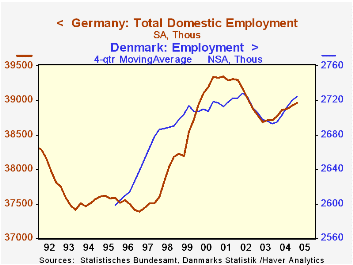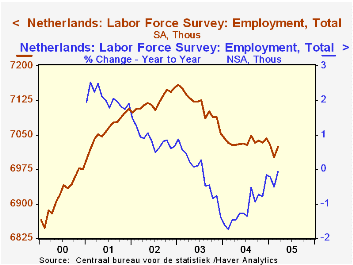 Global| May 19 2005
Global| May 19 2005Employment Gains in Germany, Denmark; Decline in Netherlands Is Moderating
Summary
Employment conditions in several countries are showing some improvement. After about three years of decline or sluggishness, uptrends are developing in the number of people employed. This is evident in Germany, where seasonally [...]

Employment conditions in several countries are showing some improvement. After about three years of decline or sluggishness, uptrends are developing in the number of people employed. This is evident in Germany, where seasonally adjusted employment rose 38,000 in Q1, extending the recent string of gains to a fifth quarter. At 39.965 million, the level is the highest since the third quarter of 2002. Before seasonal adjustment, the figure is 39.579 million, up 0.5% from a year ago.
In Denmark, the lack of seasonal adjustment makes the comparisons less obvious, but gains are there, nonetheless. At 2.698 million in Q1, jobs are up 0.7% from a year ago and achieved the highest Q1 total since 1999. As seen in the first graph, the 4-quarter moving average has been rising since Q1 2004.
In both of these countries, it is the service sector where turnarounds are evolving. In Germany, this segment, represented by total employment less agriculture, industry and construction, was up in Q1 by 356,000 from a year ago, growth of 1.3%. Industry employment is still decreasing, down 1.2% in the same time span. This is, however, a slower pace of decline than was experienced from the beginning of 2002 to the middle of last year. Quarterly patterns are more erratic in Denmark, but recent 4-quarter growth rates in service industries have also averaged 1.3%. Industry employment is still weak, but looks to be trying to bottom out, maintaining a tight range around 440,000 for the last year.
Finally, in the Netherlands, total employment hit a new cyclical low of 7.001 million (seasonally adjusted) in February, but rebounded to 7.024 million in March. These data are expressed as three-month centered moving averages, so the good rise reported for March (average of February, March and April) suggests that the April figure alone probably had a more significant increase. As it stands, before seasonal adjustment, the March level is just barely below March 2004, the least weak reading since August 2003.
| Industrial Countries Not Seasonally Adjusted |
Mar 2005 | Feb 2005 | Year Ago | 2004 | 2003 | 2002 |
|---|---|---|---|---|---|---|
| Germany-Total Employment | 38579* | 38376* | 38861 | 38720 | 39092 | |
| Industry | 7910* | 8009* | 8018 | 8139 | 8356 | |
| Services | 27743* | 27387* | 27708 | 27379 | 27392 | |
| Netherlands - Employment | 7024 | 7001 | 7033 | 7036 | 7113 | 7123 |
| Denmark - Employment | 2698* | 2680* | 2720 | 2693 | 2712 |
Carol Stone, CBE
AuthorMore in Author Profile »Carol Stone, CBE came to Haver Analytics in 2003 following more than 35 years as a financial market economist at major Wall Street financial institutions, most especially Merrill Lynch and Nomura Securities. She had broad experience in analysis and forecasting of flow-of-funds accounts, the federal budget and Federal Reserve operations. At Nomura Securities, among other duties, she developed various indicator forecasting tools and edited a daily global publication produced in London and New York for readers in Tokyo. At Haver Analytics, Carol was a member of the Research Department, aiding database managers with research and documentation efforts, as well as posting commentary on select economic reports. In addition, she conducted Ways-of-the-World, a blog on economic issues for an Episcopal-Church-affiliated website, The Geranium Farm. During her career, Carol served as an officer of the Money Marketeers and the Downtown Economists Club. She had a PhD from NYU's Stern School of Business. She lived in Brooklyn, New York, and had a weekend home on Long Island.





